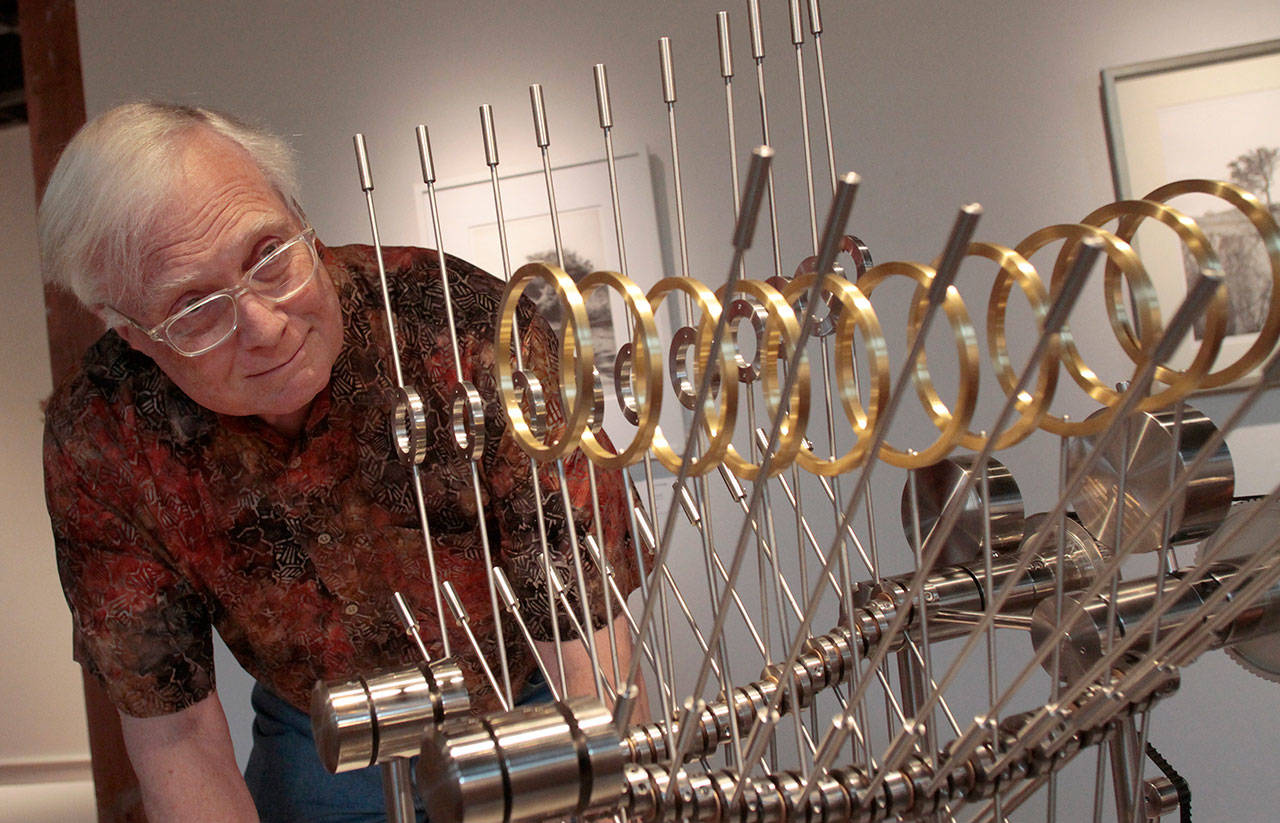Thank you for touching the art.
Yes, unlike at most gallery exhibitions, those admiring the pieces of Carl Morgan’s “Nearly Newtonian” series are encouraged to get a little handsy.
Because, captivating as they are still, it is only while they’re in motion that one gets to fully experience the synchronized beauty of Morgan’s machines, a set of 10 handmade pieces on display at Bainbridge Arts & Crafts (formerly The Art Project) through August.
The exhibition is the first dedicated showing of work by Morgan, a retired Virginia Tech-trained electrical engineer and longtime island resident, as well as a founder of the Seattle company that developed the first portable external defibrillator.
Unlike many artists, Morgan, a methodical engineer-type to his core, begins each piece with an exact result in mind. Calculations follow, then he crafts the pieces in his basement machine shop. Finally, when assembled, if he has done the math right — there are no surprises, only the joy and satisfaction of seeing the equations manifested and the physics perform.
“My game is if I don’t get the math right the sculpture won’t work,” Morgan said.
“The object of all this art is to give those principles their own expression just for their own sake. Art is not about doing a practical communication, art is about doing an emotional communication. These are, to me, emotional pieces about the way Mother Nature really works.”
Morgan has an abiding respect for Mother Nature. He says they speak the same language.
“You study physics in school and you study math in school and, unfortunately, most people will see that as something they have to get through,” he said. “Really, when it comes down to it, physics is just Mother Nature’s recipe book for the way the world works.
“I think most engineers and scientists come to appreciate the math and the physics that underlie what we do and they recognized it for its beauty,” he explained. “Our job is always to put it to work in some practical manner, to make a toaster — or a radio or an iPhone or a defibrillator, whatever it is — and that is always about channeling that stuff toward an object that then, when the public sees it, it’s not about the physics and the math or any of that stuff, it’s about your toast is going to be better. And yet the underlying beauty that people in a technical field see, it seldom gets expressed.”
Hence “Nearly Newtonian,” a myriad of mechanical configurations, large and small, inspired by things both profound and obvious, such as prairie grass blowing in the wind (“Because of Prairie Grass”); the concept of density (“Ensign Kepler Measures Dark Matter Density”); the inner machinations of the stuff inside an atom (“Niels Bohr Nukes the Pudding”); the aesthetics of fiddler crab claw size (“Fiddler Crabs Direct Beach Traffic”); the similarities between birds and wind turbines (“The Courtship Display of the Western Wind Turbine”); and even the finicky television antennas — “rabbit ears” — and beloved newsmen of yesteryear (“Tune in for Uncle Walter”), among others.
The largest of them took about five months from concept to completion; the smaller pieces six or eight weeks.
“About half the time is putting together an initial design, doing the calculations, making the drawings so that everything balances at the end … then you go build all the parts, put it together, cross your fingers and hope it works — and I’ve had a few where I got the math wrong,” Morgan said. “If you design things and build things, what you’re playing with there is the underlying structure of the world; you’re down in the basement of the world.”
Several of the pieces have already been sold since the show’s opening night unveiling on July 5, and Morgan said he’s been very pleased with the reception.
“It’s been very gratifying,” he said. “The comments were uniformly very flattering. How could you not feel good?”
More so than sales, though, Morgan the math fan has a more serious goal in mind, and a different legacy he would much prefer.
“What I’d like is for people, anybody that sees these, to appreciate that math and science can be fun,” he said. “They can be a thing worth pursuing. They can be a great career. And, especially if you’re a kid seeing stuff like this, you shouldn’t be intimidated by it; it’s something you should look forward to learning. Because it’s wonderful. That’s what I’d like to come of this.”
Bainbridge Arts & Crafts is located at 151 Winslow Way East. Visit www.theartproject.org or call 206-842-3132 for more information, descriptions of additional exhibitions and current gallery hours.
Given the enrapt stares of recent visitors, Morgan is perhaps gaining on his goal already. Showing someone the physical manifestation of an otherwise oblique and complicated theory, he said, can make all the difference in terms of appreciation and engagement.
“A lot of us, especially men, we learn better by doing stuff than by listening to stuff, if there’s this physical manipulation: going to the lab or building a thing,” he said. “And the physical manipulation of these things teaches, it somehow informs your brain in a different way.
“There’s kind of an argument about whether we discovered mathematics or invented mathematics,” Morgan said, “but mathematics is our way as a human being of relating those various elements of Mother Nature’s recipe book in a way that we can understand it and put together in ways that we can actually do something with it ourselves.
“Based on that we’ve kind of built the whole technological civilization.”


